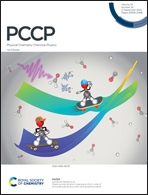Intrinsic type-II van der Waals heterostructures based on graphdiyne and XSSe (X = Mo, W): a first-principles study†
Abstract
Typical transition-metal dichalcogenides (TMDs) and graphdiyne (GDY) often form type-I heterojunctions, which will limit their applications in optoelectronic devices. Here, type-II heterojunctions based on GDY and TMDs are constructed by introducing Janus structures. An intrinsic type-II heterojunction is presented when the GDY is in contact with a Se-terminated layer, but a type-I heterojunction would appear when it is in contact with the S-terminated surface. Such a difference in band alignment can be attributed to the interaction between the dipole moment formed by the Janus structure and the graphdiyne layer. Furthermore, for heterojunctions in contact with the S-terminated layer, they can be converted into type-II heterojunctions by a small external electric field (for WSSe, only 0.05 V A−1 is required). This approach can suggest a convenient design strategy for the application of graphdiyne in a wider range of applications.



 Please wait while we load your content...
Please wait while we load your content...